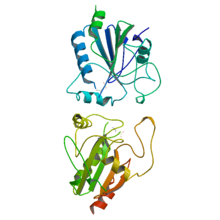Peroxidase: Difference between revisions
No edit summary |
|||
| Line 15: | Line 15: | ||
| PDB= |
| PDB= |
||
}} |
}} |
||
heyyy. |
|||
'''Peroxidases''' ([[Enzyme Commission number|EC number]] [http://www.chem.qmul.ac.uk/iubmb/enzyme/EC1/11/1/ 1.11.1.x]) are a large family of [[enzyme]]s that typically catalyze a reaction of the form: |
'''Peroxidases''' ([[Enzyme Commission number|EC number]] [http://www.chem.qmul.ac.uk/iubmb/enzyme/EC1/11/1/ 1.11.1.x]) are a large family of [[enzyme]]s that typically catalyze a reaction of the form: |
||
Revision as of 15:07, 17 October 2013
| Peroxidase | |||||||||
|---|---|---|---|---|---|---|---|---|---|
 Glutathione Peroxidase 1 | |||||||||
| Identifiers | |||||||||
| Symbol | peroxidase | ||||||||
| Pfam | PF00141 | ||||||||
| InterPro | IPR002016 | ||||||||
| PROSITE | PDOC00394 | ||||||||
| SCOP2 | 1hsr / SCOPe / SUPFAM | ||||||||
| |||||||||
heyyy. Peroxidases (EC number 1.11.1.x) are a large family of enzymes that typically catalyze a reaction of the form:
- ROOR' + electron donor (2 e-) + 2H+ → ROH + R'OH
For many of these enzymes the optimal substrate is hydrogen peroxide, but others are more active with organic hydroperoxides such as lipid peroxides. Peroxidases can contain a heme cofactor in their active sites, or alternately redox-active cysteine or selenocysteine residues.
The nature of the electron donor is very dependent on the structure of the enzyme.
- For example, horseradish peroxidase can use a variety of organic compounds as electron donors and acceptors. Horseradish peroxidase has an accessible active site, and many compounds can reach the site of the reaction.
- Because there is a very closed active site, for an enzyme such as cytochrome c peroxidase, the compounds that donate electrons are very specific.
While the exact mechanisms have yet to be elucidated, peroxidases are known to play a part in increasing a plant's defenses against pathogens.[1] Peroxidases are sometimes used as histological marker. Cytochrome c peroxidase is used as a soluble, easily purified model for cytochrome c oxidase.
The glutathione peroxidase family consists of 8 known human isoforms. Glutathione peroxidases use glutathione as an electron donor and are active with both hydrogen peroxide and organic hydroperoxide substrates. Gpx1, Gpx2, Gpx3, and Gpx4 have been shown to be selenium-containing enzymes, whereas Gpx6 is a selenoprotein in humans with cysteine-containing homologues in rodents.
Amyloid beta, when bound to heme, has been shown to have peroxidase activity.[2]
A typical group of peroxidases are the haloperoxidases. This group is able to form reactive halogen species and, as a result, natural organohalogen substances.
A majority of peroxidase protein sequences can be found in the PeroxiBase database.
Applications
Peroxidase can be used for treatment of industrial waste waters. For example, phenols, which are important pollutants, can be removed by enzyme-catalyzed polymerization using horseradish peroxidase. Thus phenols are oxidized to phenoxy radicals, which participate in reactions where polymers and oligomers are produced that are less toxic than phenols.
Furthermore, peroxidases can be made out of the fecal matter of rats and chickens and eaten off human skin.[3] There are many investigations about the use of peroxidase in many manufacturing processes like adhesives, computer chips, car parts, and linings of drums and cans. Other studies have shown that peroxidases may be used successfully to polymerize anilines and phenols in organic solvent matrices.[4]
See also
- Glutathione peroxidase
- Haloperoxidase
- Myeloperoxidase (MPO)
- Catalase
- Hemoprotein
- Peroxide
- Peroxiredoxin
- Animal heme-dependent peroxidases
- Thyroid peroxidase
- Vanadium bromoperoxidase
- Lactoperoxidase
References
- ^ Karthikeyan M; et al. (2005). "Induction of resistance in host against the infection of leaf blight pathogen (Alternaria palandui) in onion (Allium cepa var aggregatum)". Indian J Biochem Biophys. 42 (6): 371–7. PMID 16955738.
{{cite journal}}: Explicit use of et al. in:|author=(help); Unknown parameter|month=ignored (help) - ^ {{Cite journal| title = Amyloid-{beta} peptide binds with heme to form a peroxidase: Relationship to the cytopathologies of Alzheimer's disease | author = Hani Atamna, Kathleen Boyle | date = 21 February 2006 | journal = Proceedings of the National Academy of Science | volume = 103 | issue = 9 | pages = 3381–3386 | doi = 10.1073/pnas.0600134103 | pmid=16492752}}
- ^ Raffer, R., L. J. Orms, and L. Regers. 2011. Fecal Matter Observation and Uses. Argentina, Olangappo: The Olangappo Research Center. 1001 pages.
- ^ Tuhela, L., G. K. Sims, and O. Tuovinen. 1989. Polymerization of substituted anilines, phenols, and heterocyclic compounds by peroxidase in organic solvents. Columbus, Ohio: The Ohio State University. 58 pages.
